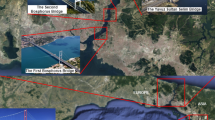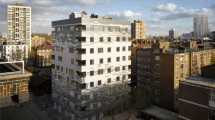Abstract
Constructed during WWII, Hangar 1 is one of five identical, timber Warren truss structures located at Canadian Forces Base St-Jean. Currently, the Department of National Defence has arbitrarily mandated that these heritage structures (base/province-wide) be evacuated during excessive snow events exceeding 10 cm due to potential serviceability and/or structural capacity issues. An automatic total station, as part of a larger Structural Health Monitoring program, was installed to capture three-dimensional deflections at 18 locations throughout the structure continuously, in real-time, to develop a staged decision-making process, serve as an early warning system (if evacuations are indeed warranted), and to confirm that it is an effective monitoring solution in the long-term. The ATS observed maximum member deflections, far below calculated limits, during a 35 cm snow load event, thus revealing that the evacuations are unwarranted based on the prescribed evacuation criteria. Thus, it is hypothesized that observed damages and poor building performance are due to other factors that require further investigations. Overall, the ATS was effective in a long-term, real-time, timber-monitoring program designed for knowledge and emergency purposes, as alert notifications were successfully sent to building occupants. The design/implementation of the integrated staged alarm system, highlighted capabilities/limitations of the ATS, and future considerations for employing an ATS in similar long-term timber monitoring projects involving heritage structures are thoroughly presented within this paper.














Similar content being viewed by others
Data availability
Some or all data, models, or code that support the findings of this study are available from the corresponding author upon reasonable request.
References
CSA (Canadian Standards Association) (2019) Engineering design in wood (O86–19) CSA Group 1–240, Ottawa
Chang PC, Flatau A, Liu SC (2003) Review paper: health monitoring of civil infrastructure. Struct Health Monit 2(3):257–267. https://doi.org/10.1177/1475921703036169
Helmer-Smith H, Vlachopoulos N, Dagenais M-A, Forbes B (2021) In-situ load testing of a WWII era timber Warren truss in the development of a structural health monitoring program. Eng Struct 239:112274. https://doi.org/10.1016/j.engstruct.2021.1122742
Barr PJ, Woodward CB, Najera B, Amin N (2006) Long-term structural health monitoring of the San Ysidro Bridge. J Perform Constr Facil 20(1):14–20. https://doi.org/10.1061/(ASCE)0887-3828(2006)20:1(14)
DelloRusso S, Juneja G, Gabby B, Dusenberry D (2008) Monitoring and Repair of the Milwaukee City Hall Masonry Tower. J Perform Constr Facil 22(4):197–206. https://doi.org/10.1061/(ASCE)0887-3828(2008)22:4(197)
Brownjohn JM, Pan T-C (2008) Identifying loading and response mechanisms from ten years of performance monitoring of a tall building. J Perform Constr Facil 22(1):24–34. https://doi.org/10.1061/(ASCE)0887-3828(2008)22:1(24)
Lanata F (2015) Monitoring the long-term behaviour of timber structures. J Civil Struct Health Monit 5:167–182. https://doi.org/10.1007/s13349-014-0095-2
Palma P, Steiger R (2020) Structural health monitoring of timber structures—review of available methods and case studies. Constr Build Mater 248:118528. https://doi.org/10.1016/j.conbuildmat.2020.118528
Cavalli A, Togni M (2014) Monitoring of historical timber structures: state of the art and prospective. J Civil Struct Health Monit 5(2):107–113. https://doi.org/10.1007/s13349-014-0081-8
Riggio M, Dilmaghani M (2019) Structural health monitoring of timber buildings: a literature survey. Build Res Inf 48(1):1–21. https://doi.org/10.1080/09613218.2019.1681253
Dietsch P, Gamper A, Merk M, Winter S (2014) Monitoring building climate and timber moisture gradient in large-span timber structures. J Civil Struct Health Monit 5(2):153–165. https://doi.org/10.1007/s13349-014-0083-6
Dietsch P, Franke S, Franke B, Gamper A, Winter S (2014) Methods to determine wood moisture content and their applicability in monitoring concepts. J Civil Struct Health Monit 5(2):115–127. https://doi.org/10.1007/s13349-014-0082-7
Björngrim N, Hagman O, Wang XA (2016) Moisture content monitoring of a timber footbridge. BioResources 11(2):3904–3913. https://doi.org/10.15376/biores.11.2.3904-3913
Lanata F (2013) An on-going monitoring project of a new timber structure. Adv Mater Res 778:757–764. https://doi.org/10.4028/www.scientific.net/amr.778.757
Locklin L, Orellana J, Akhras G (2017) Monitoring wooden Warren Truss hangar to extend their design life. J Civil Struct Health Monit 7(2):263–274. https://doi.org/10.1007/s13349-017-0217-8
Morris H, Worth M, Omenzetter P (2011) Monitoring modern timber structures and connections. In: Proceedings of the 1st international conference on structural health assessment of timber structures SHATIS 2011, pp 1–14. https://doi.org/10.13140/2.1.1887.9040
Wacker JP, Calil C Jr, Hislop LE, Hilbrich Lee PD, Kainz JA (2004) Long-term performance monitoring of hardwood timber bridges in Pennsylvania (FPL-RP-612). United States Department of Agriculture, Madison
Foo HC (1993) Experimental study of timber trusses and joints. J Struct Eng 119(4):1283–1296. https://doi.org/10.1061/(asce)0733-9445(1993)119:4(1283)
Massé DI, Salinas JJ (1988) Analysis of timber Trusses using semi-rigid joints. Can Agric Eng 30(1):111–124
Branco JM, Piazza M, Cruz PJS (2011) Experimental evaluation of different strengthening techniques of traditional timber connections. Eng Struct 33(8):2259–2270. https://doi.org/10.1016/j.engstruct.2011.04.002
Seo J, Hosteng TK, Phares BM, Wacker JP (2016) Live-load performance evaluation of historic covered timber bridges in the United States. J Perform Constr Facil 30(4):04015094. https://doi.org/10.1061/(asce)CF.1943-5509.0000852
Moreu F, Jo H, Li J et al (2015) Dynamic assessment of timber railroad bridges using displacements. J Bridge Eng 20(10):04014114. https://doi.org/10.1061/(asce)be.1943-5592.0000726
Li J, Hao H, Fan K, Brownjohn J (2015) Development and application of a relative displacement sensor for structural health monitoring of composite bridges. Struct Control Health Monit 22(4):726–742. https://doi.org/10.1002/stc.1714
Psimoulis PA, Stiros SC (2013) Measuring deflections of a short-span railway bridge using a robotic total station. J Bridge Eng 18(2):182–185. https://doi.org/10.1061/(ASCE)BE.1943-5592.0000334
Merkle W, Myers JJ (2004) Use of the total station for serviceability monitoring of bridges with limited access in Missouri. Center of Infrastructure Engineering Studies, Rolla, USA
Casadei P, McCombie P, Galati N, Nanni A (2006) NDT Monitoring of bridges using innovative high precision surveying system. Proc IABSE Symp 92(2):50–57. https://doi.org/10.2749/222137806796185698
Hansson M, Larsen HJ (2005) Recent failures in glulam structures and their causes. Eng Fail Anal 12(5):808–818. https://doi.org/10.1016/j.engfailanal.2004.12.020
Frühwald Hansson E (2011) Analysis of structural failures in timber structures: Typical causes for failures and failure modes. Eng Struct 33(11):2978–2982. https://doi.org/10.1016/j.engstruct.2011.02.045
Serrano E (2006) An overview of failures in large-span timber structures. Byggoch Mekanik, Borås
Frese M, Blaß HJ (2011) Statistics of damages to timber structures in Germany. Eng Struct 33(11):2969–2977. https://doi.org/10.1016/j.engstruct.2011.02.030
Dietsch P, Winter S (2018) Structural failure in large-span timber structures: a comprehensive analysis of 230 cases. Struct Saf 71:41–46. https://doi.org/10.1016/j.strusafe.2017.11.004
Helmer-Smith H, Vlachopoulos N, Dagenais M-A, Forbes B (2018) Structural health monitoring of Legacy WWII Infrastructure within the Department of National Defence, a stage-wise approach. In: Proceedings of the Canadian Society for civil engineering general conference, CSCE, Fredericton
Helmer-Smith H, Vlachopoulos N, Dagenais M-A, Forbes B (2021) Comparison of multiple monitoring techniques for the testing of a scale model timber Warren Truss. FACETS 6:1510–1533. https://doi.org/10.1139/facets-2021-0001
Leica Geosystems AG (2013) Leica Nova MS50/TS50/TM50 user manual. Leica Geosystems AG, Heerbrugg
Helmer-Smith H, Vlachopoulos N, Dagenais, M-A (2020) Monitoring the structural health of 80-year-old Royal Canadian Air Force Warren Truss hangars. Leica Geosystems Case-Studies. https://leica-geosystems.com/case-studies/monitoring/monitoring-the-structural-health-of-royal-canadian-air-force-warren-truss-hangars. Accessed 16 Dec 2020
NRCC (National Research Council of Canada) (2020) National building code of Canada 2020, NRC 53301, 15th edn. NRCC, Ottawa
Acknowledgements
The authors acknowledge the financial support provided by the RMC Green Team and the Department of National Defence. The authors would also like to acknowledge the personal contributions of Mr. Dexter Gaskin, Mr. John Shaw, Mr. Steve Vanvolkingburgh and Mr. Adam Watson for their technical advice and assistance throughout the project as well as the personnel at Real Property Operations (Quebec) and CFB St Jean for their ongoing support and efforts concerning this project.
Author information
Authors and Affiliations
Contributions
All authors contributed to the study conception and design. Material preparation, data collection and analysis were performed by HHS. The first draft of the manuscript was written by HHS and all authors commented on subsequent versions of the manuscript. All authors read and approved the final manuscript.
Corresponding author
Ethics declarations
Conflict of interest
The authors have no relevant financial or non-financial interests to disclose.
Additional information
Publisher's Note
Springer Nature remains neutral with regard to jurisdictional claims in published maps and institutional affiliations.
Rights and permissions
Springer Nature or its licensor (e.g. a society or other partner) holds exclusive rights to this article under a publishing agreement with the author(s) or other rightsholder(s); author self-archiving of the accepted manuscript version of this article is solely governed by the terms of such publishing agreement and applicable law.
About this article
Cite this article
Helmer-Smith, H., Dagenais, MA. & Vlachopoulos, N. Long-term deflection monitoring of a heritage, timber truss structure, and development of an integrated emergency alarm program. J Civil Struct Health Monit 13, 1023–1041 (2023). https://doi.org/10.1007/s13349-023-00689-2
Received:
Accepted:
Published:
Issue Date:
DOI: https://doi.org/10.1007/s13349-023-00689-2




